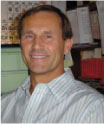Enhancing reliability of elemental speciation results – quo vadis?
Ralph E. Sturgeon A C and Kevin A. Francesconi BA Institute for National measurement Standards, National Research Council Canada, Ottawa, ON, K1A 0R9, Canada.
B Institute of Chemistry – Analytical Chemistry, Karl-Franzens University Graz, 8010 Graz, Austria.
C Corresponding author. Email: ralph.sturgeon@nrc.ca

Ralph Sturgeon is currently a Principal Research Officer and Group Leader for Chemical Metrology at the Institute for National Measurement Standards, National Research Council Canada. His interests lie in inorganic analytical chemistry, comprising trace element analysis, vapor generation, instrument development, organometallic speciation and production of Certified Reference Materials with a focus on atomic and mass spectrometric detection. He is an Editor for Spectrochimica Acta Reviews, and currently serves on the advisory boards of eight other international analytical chemistry journals. His contributions to analytical atomic spectroscopy have been recognised through a number of awards, including Fellowship in the Chemical Institute of Canada (1990), the Barringer (1986) and Herzberg (2002) awards of the Spectroscopy Society of Canada, the McBryde Medal (1990) and Maxxam Award (2007) from the Chemical Institute of Canada and the Ioannes Marcus Marci award (1998) of the Czech Spectroscopic Society. |

Kevin Francesconi, a graduate from Curtin University of Technology (B.App.Sc.) and the University ofWestern Australia (M.Sc. and Ph.D. in organic chemistry), worked in Australia for over 15 years in marine environmental research before moving in 1996 to the Ecotoxicology Group at the University of Southern Denmark. In 2002, he moved toAustria where he is currently Professor of Analytical Chemistry at the Karl-Franzens University, Graz. His research is focussed on biotransformation processes for metals and metalloids in the environment, and their implications for human health. |
Environmental Chemistry 6(4) 294-297 https://doi.org/10.1071/EN09074
Submitted: 19 June 2009 Accepted: 27 July 2009 Published: 25 August 2009
Environmental context. The majority of publications reporting research in the field of metal speciation devote too little effort to ensuring quality, reliability or traceability of data. This essay discusses the current state of practice and proposes that we adopt a minimum set of standards or benchmarks to which such studies should be held accountable.
[1]
[2]
[3]
[4]
D. M. Templeton ,
F. Ariese ,
R. Cornelis ,
L.-G. Danielsson ,
H. Muntau ,
H. P. van Leeuwen ,
R. Lobinski ,
Guidelines for terms related to chemical speciation and fractionation of elements. Definitions, structural aspects, and methodological approaches (IUPAC Recommendations 2000).
Pure Appl. Chem. 2000
, 72, 1453.
| Crossref | GoogleScholarGoogle Scholar |
CAS |
[Verified 12 August 2009]
[12]
P. Quevauviller ,
Traceability of environmental chemical analyses: can theory match practice?
Anal. Bioanal. Chem. 2005
, 382, 1800.
| Crossref | GoogleScholarGoogle Scholar |
CAS |
PubMed |
[Verified 12 August 2009]
[14]
[15]
[16]
M. J. T. Milton ,
T. J. Quinn ,
Primary methods for the measurement of amount of substance.
Metrologia 2001
, 38, 289.
| Crossref | GoogleScholarGoogle Scholar |
CAS |

[17]
[18]
J. Meija ,
Z. Mester ,
Paradigms in isotope dilution mass spectrometry for elemental speciation analysis.
Anal. Chim. Acta 2008
, 607, 115.
| Crossref | GoogleScholarGoogle Scholar |
CAS |
PubMed |

[19]
J. Meija ,
L. Ouerdane ,
Z. Mester ,
Isotope scrambling and error magnification in multiple-spiking isotope dilution.
Anal. Bioanal. Chem. 2009
, 394, 199.
| Crossref | GoogleScholarGoogle Scholar |
CAS |
PubMed |

[20]
L. Rottmann ,
K. G. Heumann ,
Development of an on-line isotope dilution technique with HPLC/ICP-MS for the accurate determination of elemental species.
Fresenius J. Anal. Chem. 1994
, 350, 221.
| Crossref | GoogleScholarGoogle Scholar |
CAS |

[21]
H. Haraguchi ,
Metallomics as integrated biometal science.
J. Anal. At. Spectrom. 2004
, 19, 5.
| Crossref | GoogleScholarGoogle Scholar |
CAS |

[22]
D. W. Koppenaal ,
G. M. Hieftje ,
Metallomics – the future of atomic spectroscopy?
J. Anal. At. Spectrom. 2007
, 22, 111.
| Crossref | GoogleScholarGoogle Scholar |
CAS |

[23]
G. Koellensperger ,
M. Groeger ,
D. Zinkl ,
P. Petzelbauer ,
S. Hann ,
Quantification of elemental labeled peptides in cellular uptake studies.
J. Anal. At. Spectrom. 2009
, 24, 97.
| Crossref | GoogleScholarGoogle Scholar |
CAS |

[24]
M. J. Previs ,
P. VanBuren ,
K. J. Begin ,
J. O. Vogoreaux ,
M. M. LeWinter ,
D. E. Matthews ,
Quantification of protein phosphorylation by liquid chromatography–mass spectrometry.
Anal. Chem. 2008
, 80, 5864.
| Crossref | GoogleScholarGoogle Scholar |
CAS |
PubMed |

[25]
J. Feldman ,
P. Salaün ,
E. Lombi ,
Critical review perspective: elemental speciation analysis methods in environmental chemistry – moving towards methodological integration.
Environ. Chem. 2009
, 6, 275.
| Crossref | GoogleScholarGoogle Scholar |

[26]
D. Horrobin ,
Something rotten at the core of science?
Trends Pharmacol. Sci. 2001
, 22, 51.
| Crossref | GoogleScholarGoogle Scholar |
CAS |
PubMed |



